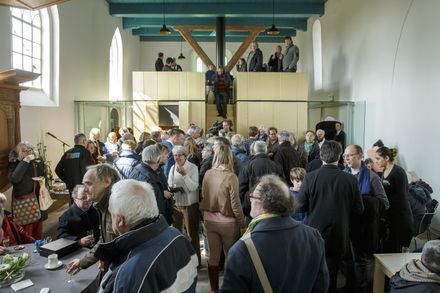Leegkerk Church Interior Renovation
ARCHITECTS
Awg Architects
ARCHITECTS IN CHARGE
Jan Verrelst, Maarten Verdonschot
SERVICES ENGINEER
Adviesbureau Feijen
PROJECT TEAM
Jan Verrelst, Maarten Verdonschot, Gill Bruggeman, Marijn Wittewrongel
BUILD SUPPORT
Adviesbureau Van Der Plas
PRINCIPAL CONTRACTOR
Friso Totaalbouw
STRUCTURE ENGINEER
Ingenieursbureau Dijkhuis
SUBCONTRACTORS
Martin De Boer, Van Seggeren Techniek
PHOTOGRAPHS
Harold Koopmans, Omke Oudeman
AREA
550 M²
YEAR
2013
LOCATION
Groningen, The Netherlands
CATEGORY
Educational Architecture, Renovation
The historic Leegkerk church, a national monument, dates from the thirteenth and sixteenth centuries. It was originally conceived as a place for contemplation, assembly and refuge on high ground.
Leegkerk church is inextricably linked to the locale and to the people of the province of Groningen.
The foundations “Stichting Oude Groninger Kerken” and “Bijzondere Locaties Groningen” realized that Leegkerk church merited a new function as a center for appreciation of the environment and their (cultural) history.
The foundations saw that the church needed to be integrated into their (super)regional recreational/educational networks. Furthermore it was essential that the church retain its original, “traditional” multifunctional spaces for social, cultural and spiritual activities.
The range of facilities and their quality - both technical and ‘emotive’ – necessitated preeminent treatment. The architecture firm awg architecten, from Antwerp, designed a new interior to achieve these ends and to add a new layer to the church’s long and significant history.
Certain (prosaic) additions that are necessary for the church’s infrastructure are now housed in a free-standing volume that was constructed to be as compact as possible: a golden cube, a treasure chest as it were, a shrine. New (revolving) golden cabinets between the nave and the choir function as rotating room dividers.
Ample space for modern pursuits is reconfirmed thanks to these additions.Setting the cube at the center of the church, detached from any walls, defines functional zones and maximizes spatial experience.
Placing the education and exhibition space on top of this volume, accessible by an almost monumental staircase, accentuates its broad range of possible functions.From this “balcony/stage” it is possible not only to oversee the church interior but also to overlook the landscape of Groningen from an entirely new perspective.

























